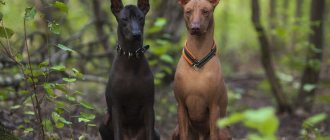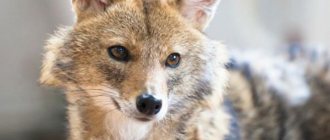The Petersburg Orchid dog breed appeared recently.
In 1997, Russian cynologist and dog breeder N. Nasibova developed a new breed of miniature indoor dogs, which in 2007 was included in the register of State-protected breeding achievements. The appearance of the breed was timed to coincide with the 300th anniversary of St. Petersburg, which, in fact, determined its name. It took 3 years to get a new breed of dog. Several miniature breeds were taken as a basis, the author does not disclose which ones. The “Petersburg Orchid” has not currently received recognition from international cynological associations. Dogs of this breed are known only in Russia.
History of the St. Petersburg Orchid breed
The idea of creating the breed belonged to Nina Nasibova, the owner of the S Lake Dolgoe nursery, which specialized in breeding Russian toys.
In the 90s, the breeder wanted to give the world a new variety of decorative dogs that combine external charm, but do not require complex grooming and specific care. As a result, the experiment was carried out with the participation of representatives of various toy breeds, which produced heterogeneous offspring in terms of further breeding. Work on the formation of the “orchid” phenotype continued for several years. Moreover, according to Nina Nasibova herself, most of the puppies born were given away for free, as they did not meet her expectations. It was possible to obtain the first individuals similar to today’s “Petersburgers” only in 1997. At the same time, information about the breeding sires used for mating was carefully hidden. According to one version, the owner of the nursery planned in this way to protect the breed from uncontrolled breeding by unscrupulous breeders. On the other hand, for commercial reasons and the desire to retain exclusive copyright.
One way or another, already in 2007 a patent was issued in the name of Nina Nasibova, and her charges received their registration number from the Ministry of Agriculture. So far, the St. Petersburg Orchid breed is in developing status, while at the same time, most of its representatives receive full pedigrees when sold. There is one more interesting nuance that limits the breeding of cute shaggy dogs: at the request of the breeder, mainly pet and show puppies are sold outside the Leningrad region, as well as abroad.
Breed characteristics and character traits
Dogs of the St. Petersburg Orchid breed are distinguished by their intelligence, intelligence, and unobtrusive friendliness. They are affectionate and gentle, so they need a warm response. Owners of babies claim that during times of blues and bad mood there is nothing better than communicating with a pet.
Animals are devoid of aggression, they joyfully greet guests, willingly meet strangers, play with children and other animals. Although the pet is happy to be in the spotlight, it will not get in the way. Therefore, the St. Petersburg Orchid is a dog that will become an excellent companion for a person of any age.
Important! For people suffering from allergies, orchids are a godsend. Dogs are not subject to shedding and do not smell like dogs.
Dogs behave calmly in their arms during walks or at a party. The only problem is the dog’s physique, which, due to carelessness, can be injured by the owner himself.
Breed standard St. Petersburg Orchid
Representatives of the breed are compact, elongated dogs that are distinguished by exemplary behavior at home, but love to be active during a walk, if one happens. There are standard (2-4 kg) and low-weight “orchids”, whose body weight ranges from 700 g to 2 kg. Little dogs look incredibly cute and are very popular, but due to anatomical features that complicate reproductive processes, they are never sold as breeding pets.
The height of an adult St. Petersburg orchid is up to 30 cm at the withers, so all individuals that have crossed this barrier are considered plembrac. The minimum height limit for a dog is 17 cm. Sexual dimorphism in the breed is very weak, which greatly facilitates the choice of a pet if only the exterior characteristics of the dog are important to the potential owner.
Head
The rounded skull of the St. Petersburg orchid fits well into the square shape. The dog's light, dry head is distinguished by its straight contours and medium size. Mandatory breed condition: the length of the muzzle must be at least ⅓ of the length of the head.
The faces of St. Petersburg orchids may be slightly pointed in the nose area, but the classic narrowed shape is not typical for them. The stop is distinct without being overly sharp, and the under-eye area is well filled. The line of the muzzle is always parallel to the frontal line.
Lips and teeth
The lips are dry rather than fleshy, fitting closely to the teeth. The teeth are small, forming a scissor-shaped bite in the bow. It is always preferable to have a complete dental formula.
Nose
The lobe is very small, matching the color of the main color or a rich black tone.
Eyes
The eyes of the St. Petersburg orchid have a straight and wide fit with a very dark iris color. The eyelid section is oval-almond-shaped.
Ears
The medium-sized ears have rounded tips and hang spectacularly on cartilage. The ear flap is evenly covered with hair.
Neck
The long, distinctly dry neck is characterized by a slight bend.
Frame
The bodies of St. Petersburg orchids are elongated, having an elongation range of 106-108. The moderately convex withers are continued by a straight line of the back, forming a convex zone only in the lumbar region. The wide croup is characterized by a barely noticeable slope with an angle of inclination from 15 to 30°. The chest is distinguished by normal depth and good width for a decorative dog. The stomach is strongly tucked.
Tail
Tail docking is allowed. If the docking procedure was not carried out, the tail takes the shape of a saber, or less often - a ring.
Limbs
The length of the legs of the St. Petersburg orchid is ½ of its height (at the withers). Parallelism and straightness of the forelimbs are mandatory breed characteristics. The shoulder angles range from 90 to 110 degrees, the elbows are close to the sides of the dog, and the pasterns are vertical. The hind legs of "orchids" are held parallel, showing well-defined articulation angles and steep metatarsals. The paws are small, in a ball. The movements are fast, with parallel extension of the limbs and a good push.
Color
Formally, the St. Petersburg orchid can have fur of any color except white. At the same time, the palette of permitted colors is replenished from time to time with some new “specimen”. The most common breed colors today are:
- brindle (graded from red to gray);
- all variants of red;
- black and tan with tan from light gray to brick red;
- fawn;
- black;
- cognac;
- cream rose;
- chocolate and tan;
- chocolate;
- zonal in different tones;
- lilac;
- blue;
- silver
Acceptable features include small white markings on the chest, paws and muzzle. The presence of masks on the faces and so-called belts on the backs of animals is regarded as a normal exterior phenomenon.
Wool
The guard hair is quite long, soft and much larger than the undercoat. In some individuals, the fur has a slightly wavy structure. For all representatives of the breed, a special type of haircut has been developed, which is called orchid. The peculiarity of grooming an animal is that the hair on its back and neck is removed in the same way as that of a cocker spaniel. The mustache, beard, bangs and ears remain covered with a layer of soft hair. Also, the hair is cut from the knuckles, and the hair on the lower body and sides is styled into a full skirt.
Important: not long ago, a short-haired variety of the breed appeared, called the Neva Orchid. Neva dogs look a little less glamorous than their shaggy relatives, but they do not need a haircut.
Wardrobe for a pet
The little pet is very beautiful and delights passers-by with its appearance. But in the cold season it needs warmth. Specialized dog clothing stores can offer a variety of costumes and shoes. For cold weather, overalls will be required. In winter, such dogs must wear boots, otherwise their paws will freeze and the reagent will corrode the skin.
For a social event or party, there are tailcoats and dresses on sale.
You can also choose home clothes for your pet, such as pajamas. The St. Petersburg orchid requires special treatment. Care and love are the main conditions for the happiness and health of a pet. When choosing this breed, you need to be prepared for the fact that appearance will be of paramount importance. It must be decorated, and then it will become an adornment for its owner.
Today there are about 900 representatives of the St. Petersburg orchid. The price range varies from 15 to 40 thousand.
Character of the St. Petersburg orchid
When creating the breed, attention was focused on developing in its representatives those qualities that would allow them to become ideal companions for residents of the metropolis. As a result, St. Petersburg orchids turned out to be comfortable in all respects and the most urbanized pets. These glamorous kids are never sad, radiating round-the-clock positivity, and they are equally willing to frolic on a walk and sit on the sofa in front of the TV in company with their owner.
Despite their almost dwarf dimensions, St. Petersburg orchids are not at all cowardly and have a consistent character. They are not characterized by nervous tantrums and barking “just because they’re bored,” but they get along well with all representatives of the domestic fauna. Accordingly, if you need a dog that will find a common language with your independent cat, it’s worth taking a closer look at the “orchid”.
Indiscriminateness in expressing feelings of affection is a trait that was purposefully developed in representatives of the breed. The St. Petersburg Orchid is that rare type of dog that equally loves, respects and obeys all family members. Moreover, these stylish kids are very trusting, so they are ready to jump into the arms of any person who enters the house. As for guard skills, “orchids” are not outsiders in this field either. Of course, such a tiny “tail” is not able to scare an intruder, but it will be ideal for spreading the news that someone else is trying to break into the apartment.
Another interesting behavioral trait of the breed is the ability to adapt to the pace of life of the owner. Breeders assure whether a dog will grow up to be a darling of the sofa or become a flamboyant fidget depends only on the person. The “orchids” themselves perceive quite normally both a passive lifestyle and its opposite version.
Walk
A dog of the St. Petersburg Orchid breed does not need constant walking, but taking it out into the fresh air is recommended for physical activity and the prevention of obesity. Immediately while the puppy is small, you need to introduce him to a leash and collar. The dog must understand that he is led by his owner, and not vice versa.
Note! In crowded and possibly risky places, it is worth taking the baby in your arms. When walking a dog, you need to pay attention to the fact that other animals can offend it: not only relatives, but even cats.
Education and training
St. Petersburg orchids are celebrities of the dog world, who more often sit under the arms of their owners at social events than run along the paths of parks. For this reason, classical training for the breed is not as important as good education. Fluffy “St. Petersburgers” are smart, curious and willing to learn everything new, but only if the owner did not waste time and organized the learning process correctly. The most common mistake in raising a St. Petersburg orchid is connivance and the hope that such a small pet is simply not able to ruin the owner’s life. Believe me, I still can. From the first days of life, take care of the animal seriously, but without being too harsh: remember, the breed was bred for love, not for drilling.
Typically, St. Petersburg orchids are given to new owners when they have grown up and have mastered basic behavioral rules. For example, representatives of this breed very quickly understand how to properly go to any toilet, from the tray to the diaper, and do it earlier than other puppies. Also, don’t be lazy to accustom your pet to walking on a harness: of course, you can carry the animal on the street and in your arms, but this is not entirely convenient, and it’s always useful for the “orchid” living in the apartment to run around. Mandatory commands that must be taught to a decorative dog are “Come to me!” and “You can’t!” Thanks to the first, it is convenient to control the pet’s behavior, and the second will help in stopping unwanted actions, especially when it comes to picking up conditionally edible objects on the street, which is typical for all four-legged pets.
Do not allow the puppy to argue with you, namely: growl, pull toys out of your hands with his teeth, or demonstrate disagreement with demands by biting your fingers. Of course, the tiny dog will not cause physical damage to his health, but gradually he will develop an extremely unpleasant pattern of behavior. For the same reason, the dog must know its place in the house. Even if you love it when the “orchid” sleeps peacefully next to you on the sofa, try to arrange a separate corner with a basket for it, not forgetting to practice the “Place!” command. and periodically use it when the pet intrudes into personal space too intrusively.
You won’t have to compete for leadership status with St. Petersburg orchids, but the animal still needs to show who’s boss in the house. The easiest way to do this is to feed your pet after people have eaten dinner. At the same time, no tasty compensation is offered to the four-legged prankster during the feast. This approach will help the fluffy dog quickly and correctly fit into the hierarchical family system, since the psyche of St. Petersburg orchids is the same as that of most dogs.
Advantages and disadvantages
The creators of the described decorative breed can talk for a long time about the advantages of small dogs. They have a playful disposition, are flexible, and friendly. It is recommended to have such pets in those families where there is a lack of positive emotions, since the St. Petersburg orchid can guarantee them. Communication with an animal allows you to get rid of stress and socialize the child.
Among the advantages of the breed it is worth highlighting:
- attractive appearance;
- unpretentiousness;
- small size;
- good-natured character.
If you want to devote yourself to exhibitions, then this breed is best suited. The dogs have a special appearance and are ideal for the role of champions.
With all this, they are unpretentious in food, although they need to monitor their diet, since the condition of their coat and teeth depends on the quality of food.
The small size makes it possible to keep a pet even in a small apartment, where it will not interfere. These dogs react normally to the absence of their owner, do not act out mischief and obediently wait for his arrival at home. Breeders value the St. Petersburg orchid for its complaisance and good manners. It is difficult to resist the charm of the representatives of the breed.
The animal gets along well with children and loves active games, but it should be handled very carefully. Any wrong movement can harm your pet. Of the negative qualities:
- not a security guard;
- may get sick often.
Such a dog is not able to protect its owner, but according to its breed this is not required of it. The St. Petersburg orchid is an ornamental animal that requires care and love. It is imperative to get up-to-date vaccinations.
Every time the dog is nearby, you need to be careful not to accidentally crush it. The same goes for playing with children. It is better to allow a child to approach an animal at a conscious age, otherwise it may cause injury.
Maintenance and care
In interviews with breeders about the breed, the emphasis is always on the unpretentiousness of its representatives in terms of care. But don’t take this information literally – you won’t be able to ignore the dog’s image at all. Like any decorative pet, the St. Petersburg orchid urgently needs hygiene procedures with professional cosmetic products and light grooming.
The classic care regimen is washing the wool with shampoo that prevents the formation of tangles, followed by the use of special conditioning compounds. After such products, the spine becomes smoother and does not become tangled, and a dog washed in this way can not be combed for a whole week. A breed-specific haircut that allows you to fully reveal the exterior potential of the “orchid” only looks complicated. In fact, it is easy to do it yourself, without resorting to the services of a groomer.
A pleasant bonus for all fans of the breed is the absence of seasonal shedding among its representatives. So if you prefer cleanliness, but don’t like picking up tufts of wool from carpets, St. Petersburg orchids are right up your alley. Of course, during the life of an animal, the hair of the animal periodically dies off, but if the owner does not neglect to comb the pet, there will be no scraps lying around the apartment - they will all remain on the comb. It will not be possible to avoid cleaning the ears and eyes of St. Petersburg orchids, but since this process is simple, it will not take much time. It is enough just to buy a hygienic lotion that softens the wax in the ear cup, and for the eyes use a clean cloth moistened with a decoction of chamomile flowers.
Feeding
St. Petersburg orchids are partial to standard dog treats, but they do not suffer from gluttony. A tendency towards obesity in representatives of the breed has also not been identified, so there is no need to weigh out the daily amount of food on a scale. According to N. Nasibova herself, “orchids” are able to live their entire lives on “drying”, which will not cause any damage to their health. The only obligatory condition is that the food must be of high quality and at least super-premium.
At the same time, the creator of the breed keeps her producers on the so-called species-specific diet, which implies a complete rejection of heat treatment of products. According to the breeder, this approach has a positive effect on the health of the animals’ teeth - “St. Petersburg residents” who eat natural food do not suffer from tartar, and their breath is always fresh.
So, what do the dogs eat in Nina Nasibova’s kennel? First of all, raw lean meat and offal. Once a week, adult St. Petersburg orchids are offered a fish fillet - hake, pollock, cod or sea bass, as well as one raw quail egg in the shell. In this case, cereals are completely excluded from the diet. Vegetables, fruits and young greens enter the animal’s bowl only in raw and finely chopped form. Usually, over time, dogs develop their own favorite types of plant foods. For example, some individuals respect fruits more, others are delighted with tomatoes and carrots. It is not recommended to try to change the taste preferences of the “orchid” - leave the freedom of choice to your pet.
Important: Be very careful when introducing chicken and chicken waste into your diet. St. Petersburg orchids that eat this type of meat for a long time may begin to have watery eyes and dandruff.
Adults are fed twice a day. Usually the food intake is determined by eye, depending on the pet’s physical activity. The creator of the breed recommends placing a bowl of lunch in front of the puppy and allowing no more than 10-20 minutes for the feeding process. If the dog has finished eating before, next time the portion can be slightly increased. If, on the contrary, you haven’t finished eating, then put less food in the bowl.
Cartilage, flat bones and chicken heads, as well as fermented milk products will help cover a growing dog's need for collagen and calcium. As for pharmaceutical dietary supplements, the appropriateness of their use is determined by the owner. Nina Nasibova recommends choosing natural food supplements, focusing on the fact that all the dogs in her kennel do without synthesized vitamins and give excellent offspring.
Breed care
As for caring for the St. Petersburg orchid, you don’t need to do anything supernatural. But no one canceled hygiene procedures. It is advisable to immediately accustom the dog to them:
- grooming (at least 3 times every six months);
- daily combing;
- bathing (2-3 times a month);
- cleaning teeth, ears, paraanal glands;
- rubbing the eyes.
A haircut
In order for the dog to always attract attention and please the eye, it is necessary to monitor the condition of its fur - cut it and bathe it on time.
Note! A special, one might say, signature haircut has been developed for the St. Petersburg orchid. The fur is trimmed along the body, neck, paws, between the toes, and tail. The bangs on the forehead, beard, mustache, and ears with fluffy and long hair remain uncut. The hair on the legs is trimmed.
Signature orchid haircut
Bathing
You can bathe your dog once every 8-10 days or when dirty. You should use a special shampoo for animals. After washing, you need to dry your dog with a towel and dry it with a hairdryer, then comb it. If you cannot wash your pet with water, you can use dry shampoo.
Important! It is not recommended to comb dirty or wet fur. This can lead to brittle hair, and the animal will look unkempt in appearance.
Health and diseases of St. Petersburg orchids
Since the breed continues to form, and its creator does not stop breeding experiments, it is extremely difficult to identify the pattern of development of genetic diseases in animals. It is reassuring that the breeder conducts a strict culling of puppies and sires, mating only between completely healthy individuals, which allows them to obtain healthy offspring. Separately, it should be noted the low-weight “orchids”, which, like most dwarf breeds, have an extremely fragile constitution and cannot independently produce offspring. When taking such a dog into your home, be prepared to create a safe environment for it - mini-dogs get injured very easily.
How to choose a puppy
- Choose your breeder and nursery carefully. Please note that permits for breeding St. Petersburg orchids are issued only by Nina Nasibova’s club.
- It is not recommended to take small puppies (up to 2 kg) into families with children, since an overly miniature animal is more easily injured due to careless handling.
- When selling their wards, official nurseries issue a whole package of documents, which should also include a puppy club card, personally certified by N. Nasibova.
- All purebred “orchids” must have a brand tattoo located in the groin area. The number of the brand and the animal's puppy metric must match.
- Find out how many puppies were in the litter initially. It’s great if there were no more than 3-4 kids. In litters that are too large (St. Petersburg orchids bring up to 7 puppies), animals often do not have enough mother's milk, which negatively affects their immunity.
- The cost of a puppy largely depends on its color. The most popular and expensive colors of the breed are chocolate, brindle, cognac, bright red with black.
- If you want an animal from N. Nasibova’s personal nursery, find the VKontakte page of the breed’s creator to arrange a meeting and get information about the breed from a person who knows everything about it. There you can also see a list of nurseries that have official permission from the club to sell St. Petersburg Orchid puppies.
Price
The price of the St. Petersburg orchid is determined by various factors: size, color, gender. Female puppies are sold at a price of 50 thousand rubles, male - from 30 thousand rubles. Puppies with breed defects (defects) can be purchased at a price of 15 thousand rubles. Today you can buy this dog only in N. Nasibova’s club “Petersburg Orchid”, which is the only official breeder of this breed. Here, in order to avoid “counterfeits,” puppies are branded with the letter “T” on the hip, and at two months of age they are issued a passport, vaccination certificate, etc.
Price of St. Petersburg orchid
A pet-class dog with an official package of documents from the breed club will cost 40,000 rubles. St. Petersburg orchids, which fit into the super-mini format, are more expensive. As for breeding individuals, it is quite difficult to get them, unless you are a breeder with experience and exhibition awards. The author of the breed is very sensitive to the breeding of animals, preferring to personally control all matings and selection of breeding pairs, therefore, in the vast majority of cases, potential breeders are from breeders living in the Leningrad region.











